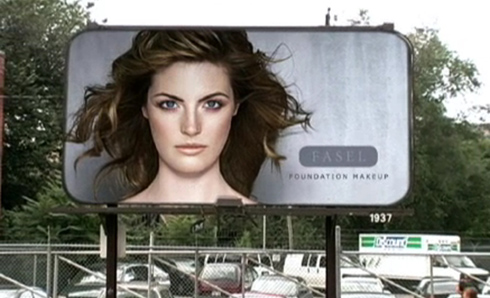Whether a person considers herself to be beautiful or hideous, an individual's expectation and desire to meet appearance standards is emotionally and psychologically consuming. Toni Morrison's The Bluest Eye illustrates the feelings of self-hatred derived from social acceptances and external attitudes towards African Americans through Pecola Breedlove's character, while Dove has created a beauty campaign in attempt to destroy any sense of personal abhorrence and establish a new idea of beauty in the minds of self-conscious individuals.
Before the novel even begins, Morrison introduces the romanticized image of beauty in the Dick and Jane reader, continued before each paragraph, claiming that blonde, light skinned, blue-eyed little girls were considered beautiful beyond any opposition. This fascination with a specific look was mimicked in media, advertisements, and consumer goods that surrounded the characters, shaping the opinions of African American girls and women that eventually would see themselves as ugly. Pecola Breedlove suffocates under this predetermined standard for so long that she begins to long for blue eyes, as if that is requirement to being beautiful. Her mind is warped by her obsession of sorts, and her thoughts explode:
"Pretty eyes. Pretty blue eyes. Big blue pretty eyes...They run with their blue eyes. Four blue eyes. Four pretty blue eyes" (46).
Formatted like the Dick and Jane books, Pecola's thoughts focus solely on her desire to be white, to be pretty, to be like Jane. If she could not completely disappear from existence, Pecola focused all of her conscious effort on shedding her ugliness or, in her mind, attaining blue eyes.
Female perceptions in the twenty-first century share the same pressures and yearnings in terms of objectified appearance.Under Dove research it was calculated that "only 4% of women around the world consider themselves beautiful," while over three fourths of women believe beauty lies within everyone but simply cannot locate their own (Dove). Unlike many commercial products that alter and mask appearances, Dove is not based on transforming the female physical image, yet building the self-esteem that makes each girl or woman comfortable in her own skin.
For their advertisements Dove doesn't look for the skinniest girl, or the tallest, or the one whose picture would appear in the mind of any girl imagining someone beautiful, but one that is real; a image that consumers and witnesses can relate to; one that is normal.
Pecola Breedlove is the ultimate victim to the four percent statistic, as she finds nothing beautiful about herself, yet discovers more and more imperfections, as do her Black friends. The girls: Pecola, Freida, and Claudia, are blatantly called ugly by their lighter-skinned classmate Maureen. Hurt and convinced of the insult's truth, the trio "walked quickly at first, and then slower, pausing every now and then to fasten garters, tie shoelaces, scratch, or examine old scars. [They] were sinking under the wisdom, accuracy, and relevance of Maureen's last words" (74). The obsessive attention to detail found in the minds of Morrison's characters is beyond that of any comfortable, confident child. The girls fasten, tie, scratch, and examine as means of pointing out each visible flaw which others point out as overriding any aspect of beauty.
It is the Dove Corporation and its campaign for real beauty that illustrates that no one resembles Jane, or in current terms, no one resembles the face staring at you from a magazine, billboard, or catalog. In the evolution video, Dove's most prominent campaign tool, a team pulls a simple girl- pieced with average blemishes and face structure- and constructs her to fit a particular image to be placed on a public billboard. The resulting picture, after the model is made over, photographed, photo-shopped, and printed captures the eyes and consumes the thoughts of numerous minds, like those of the two girls captured admiring the final picture at the end of the film.
The two images above are perceived by thousands as the same face and image, yet, behind the scenes, the first is real while the the second is completely computerized to perfection. Dove's mission is to publicize that no person fits the mold of beautiful that implants the minds of girls and women who desire such attributes for themselves. It sets out to revive senses of self-worth in those that only see ugliness, and therefore such a program could have been one to help save Pecola from self-destruction.





ryleigh--you make a very interesting connection to the Dove "real beauty" campaign. this article about a young blogger who challenged seventeen magazine to print real images of young girls reminded me of your (and morrison's) argument:
ReplyDeletehttp://www.nytimes.com/2012/05/04/nyregion/seventeen-magazine-faulted-by-girl-14-for-doctoring-photos.html?_r=1
You make a good connection between the Eurocentric standard of beauty in Morrison's The Bluest Eyes and the conception of "real beauty" in Dove. You make good comparison and introduce new fresh stuff.
ReplyDelete